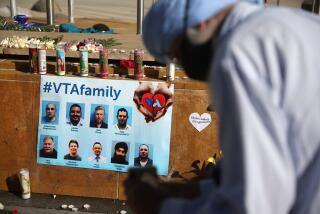Op-Ed: California needs a Gun Violence Restraining Order
- Share via
California legislators have spent much of the last two decades strengthening the state’s gun laws, but last weekend’s multiple killings in Isla Vista, Calif., by a young man previously identified by family to police as being a potential danger prove there is far more progress to be made.
Between 1999 and 2010, California reduced its gun death rate 56%, making the state a model for policymakers elsewhere seeking to reduce gun violence. California now has the ninth-lowest rate of gun death among the 50 states, but that isn’t something to celebrate in the aftermath of the Isla Vista tragedy.
Significant room for improvement exists in terms of prohibiting individuals who are at an increased risk of harming themselves and others from buying or possessing firearms. California law goes beyond the federal standard to keep guns out of the hands of dangerous individuals. For example, the state temporarily prohibits individuals from having a gun following an involuntary hospitalization for psychiatric treatment. California also prohibits those convicted of a violent misdemeanor from having a gun for five to 10 years. Individuals subject to temporary domestic-violence restraining orders are prohibited for the length of the order.
These are important policies, but more can be done at the state level to ensure that individuals who are temporarily dangerous do not have immediate access to firearms. Specifically, California can create a Gun Violence Restraining Order, a mechanism that would allow those closest to a troubled individual to act when there are warning signs or indications that that person is at risk for violence.
During the last year, I have worked as part of the Consortium for Risk-Based Firearm Policy, which is made up of mental health and public health researchers, practitioners and advocates. In December, we issued evidence-based federal and state policy recommendations to prohibit individuals who are at an increased risk of harming themselves or others from buying or possessing firearms.
In forming our recommendations, we focused on a range of risk factors that can lead to dangerous behavior. Fortunately, we know what many of these risk factors are. These include a history of violent crime, perpetration of domestic violence, alcohol abuse and drug abuse.
Some of our findings contradict conventional wisdom. For example, although mass killers with mental problems dominate headlines, only 4% of violence in the United States is attributable to persons who suffer from mental illness. Other factors play a much bigger role.
Past violence is the best predictor of future violence. We also know that alcohol and drug abuse may lead to reckless and potentially violent behavior, and policy in this area could be much more effective at both the state and federal levels if those who have been convicted of two or more DWIs or DUIs in a period of five years and those who have been convicted of two or more misdemeanor crimes involving a controlled substance in a period of five years were disqualified from accessing guns.
But there are select times when serious mental illness does increase the risk that an individual may be dangerous. Evidence demonstrates that people who have a serious mental illness in an acute stage and are not engaging in necessary treatment may be at an elevated risk of violence, especially if they have a history of violence and are abusing drugs or alcohol. Moreover, mental illnesses such as depression significantly increase the risk of suicide, which accounts for more than half of firearm deaths each year.
Instituting a Gun Violence Restraining Order in California would allow for specific interventions during critical times. In the case of the Isla Vista tragedy, the gunman’s mother had voiced concerns that brought sheriff’s deputies to her son’s apartment in late April. As that shows far too well, family members often know best when a loved one is in crisis, and in most cases want to help them. But that takes time, and having easy access to a gun — or multiple guns, in the Isla Vista case — during a potentially dangerous period increases an individual’s ability to do harm.
A Gun Violence Restraining Order would allow a judge to temporarily stop an individual from buying or possessing a firearm. The judge would examine the situation and consider all the factors suggesting that the individual was a risk to himself and others. If granted by the judge, the restraining order would have to be reassessed after a short period to restore the individual’s firearm rights if he or she is no longer at serious risk of harming himself, herself or others.
Would a Gun Violence Restraining Order law have prevented the Isla Vista killings? It’s impossible to know, but it might have helped. For 20 years, California has led the way for our nation in terms of enacting smart, evidence-based policies to curb the gun violence epidemic. Enacting such a restraining order would be the next step in what is already a proud legacy.
Renée Binder is professor of psychiatry and director of the psychiatry and law program at UC San Francisco. She is president-elect of the American Psychiatric Assn.
More to Read
A cure for the common opinion
Get thought-provoking perspectives with our weekly newsletter.
You may occasionally receive promotional content from the Los Angeles Times.










